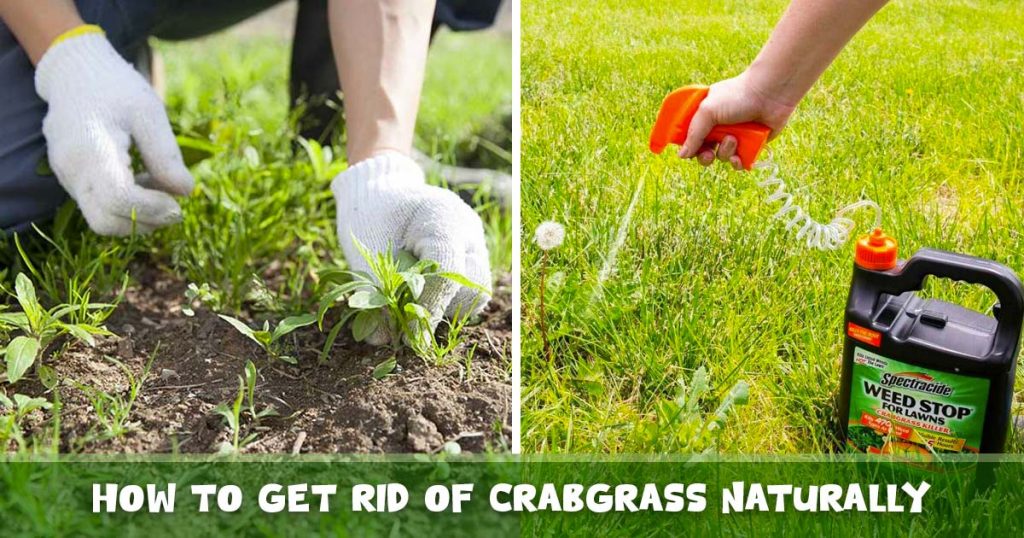Weeds are an unavoidable presence in lawns and gardens, categorized as either beneficial or harmful. Beneficial weeds, such as clover, contribute advantages like nitrogen enrichment to the soil. On the contrary, troublesome weeds like crabgrass can rapidly dominate and mar the appearance of your lawn. If you’re looking for ways to get rid of crabgrass naturally and other bothersome lawn weeds, this guide provides comprehensive information and effective organic solutions to address the issue.
What is crabgrass?
Crabgrass, known as a relentless garden weed and a gardener’s nightmare, is a common yet frustrating presence in gardens. The good news is that its prevalence comes with a variety of solutions to effectively eliminate it. Scientifically named Panicum sanguinale, crabgrass earned its moniker due to its crab-like appearance with crooked stems resembling legs. This fast-growing and spreading weed poses a challenge by hindering the growth of other grass varieties, causing unsightly bald spots, and outcompeting desired plants and crops.
Ways on How to Kill Crabgrass Naturally
Do you want to know what kills crabgrass naturally and effectively? Follow these tips and experiment with natural crabgrass killers for optimal results.
Hand Pull
The most straightforward and natural way to kill crabgrass, especially when dealing with small patches, involves manual removal by hand. However, this task poses a challenge due to crabgrass’s resilient and extensive root systems, making thorough extraction essential. Even a small section of roots left in the soil can allow crabgrass to persist and propagate. Utilizing a weeder tool can be beneficial in ensuring the removal process is more effective.
Use Vinegar
Prepare a solution by filling a spray bottle with either white vinegar or apple cider vinegar. Ensure thorough coverage of the entire weed surface, preferably during the hottest parts of the day, for maximum effectiveness. The crabgrass will undergo wilting and eventual demise, although it might require multiple applications to prevent potential regrowth from any remaining healthy roots. Some individuals suggest an enhanced or equally effective outcome by incorporating baking soda into the solution.
Boiling Water
To tackle smaller, distinct clusters of crabgrass, pouring boiling water over them is an effective method. Thoroughly soak these patches with water at the boiling point. Be cautious with this technique, as it will destroy any vegetation it touches. Additionally, it’s important to remember that multiple applications might be necessary to completely eradicate the crabgrass.
Solarization
Harnessing the sun’s energy through solarization proves to be an effective means of suffocating crabgrass. This technique is most suitable for limited areas dominated solely by crabgrass. Commence the process by mowing the weedy region at the lowest setting of your lawnmower. Subsequently, dampen the area with water. Cover the weeds with a transparent plastic sheet, securing the edges with stones. Allow it to remain in position for six weeks, and then proceed to reseed the area with the desired grass type.
Natural Weed Killers
Explore natural weed-killing alternatives to combat crabgrass, ideal for targeted applications and typically featuring child- and pet-safe ingredients like vinegar, sea salt, and soap. Another eco-friendly option is corn gluten meal, a byproduct of corn milling. This treatment not only helps control smooth crabgrass and other annual grass weeds but also contributes to natural lawn fertilization, fostering the growth of a lush, healthy lawn.
The optimal timing for application is before the full onset of the growing season, as these solutions function most effectively as pre-emergent herbicides. While certain products can address this invasive weed later on, waiting until the following spring often yields the best results.
How to Prevent Crabgrass from Growing
To thwart the invasion of crabgrass, the key is cultivating a robust lawn. Here are some tips to aid in preventing the growth of crabgrass.
Don’t Mow too Short
A leading cause of crabgrass proliferation is mowing your lawn too short, which can lead to its emergence in the form of thin, bare patches. It’s essential to mow your lawn to the appropriate height for the type of grass you have, typically between 1 to 4 inches. This practice becomes even more crucial during hot and dry weather conditions, a period when crabgrass thrives while most other grass types slow down their growth.
Autumn Lawn Care
While crabgrass tends to peak in late summer, the most effective approach to eliminating it is to consistently combat its growth throughout the entire year. Even when it appears that grass growth has halted, it continues until the first frost, necessitating regular mowing and maintenance to keep the grass healthy and prevent crabgrass invasion. Autumn provides an opportunity for lawn aeration, removing soil plugs to reduce compaction and promote deeper, stronger grass roots. Additionally, raking regularly during the fall is essential to prevent crabgrass, as fallen leaves can obstruct the sunlight needed for grass nourishment.
Regularly Water Your Lawn
While crabgrass flourishes in dry, hot conditions, the majority of grass types do not. To enhance your grass’s chances of survival, maintain a consistently moist lawn by watering regularly and ensuring the soil is uniformly damp when using a garden hose for a thorough soaking.
Reseed and Overseed
To thwart crabgrass, avoid letting it establish roots by frequently reseeding and overseeding your lawn, especially when it appears sparse. Address bare spots promptly by introducing new sod or grass seeds. Prevent crabgrass dominance by encouraging the growth of desired plants like St. Augustine grass or Kentucky bluegrass, choking out any lingering crabgrass seeds in the soil with the preferred grass seeds.
Get Rid of Crabgrass Naturally with Our Proven Methods
Take control of your lawn’s health and beauty by implementing these natural and effective strategies to combat crabgrass. From hand-pulling to innovative natural solutions and preventive measures like proper mowing and watering, you have the power to maintain a lush, crabgrass-free lawn. Start now to transform your outdoor space into a vibrant, healthy environment that thrives year-round!

